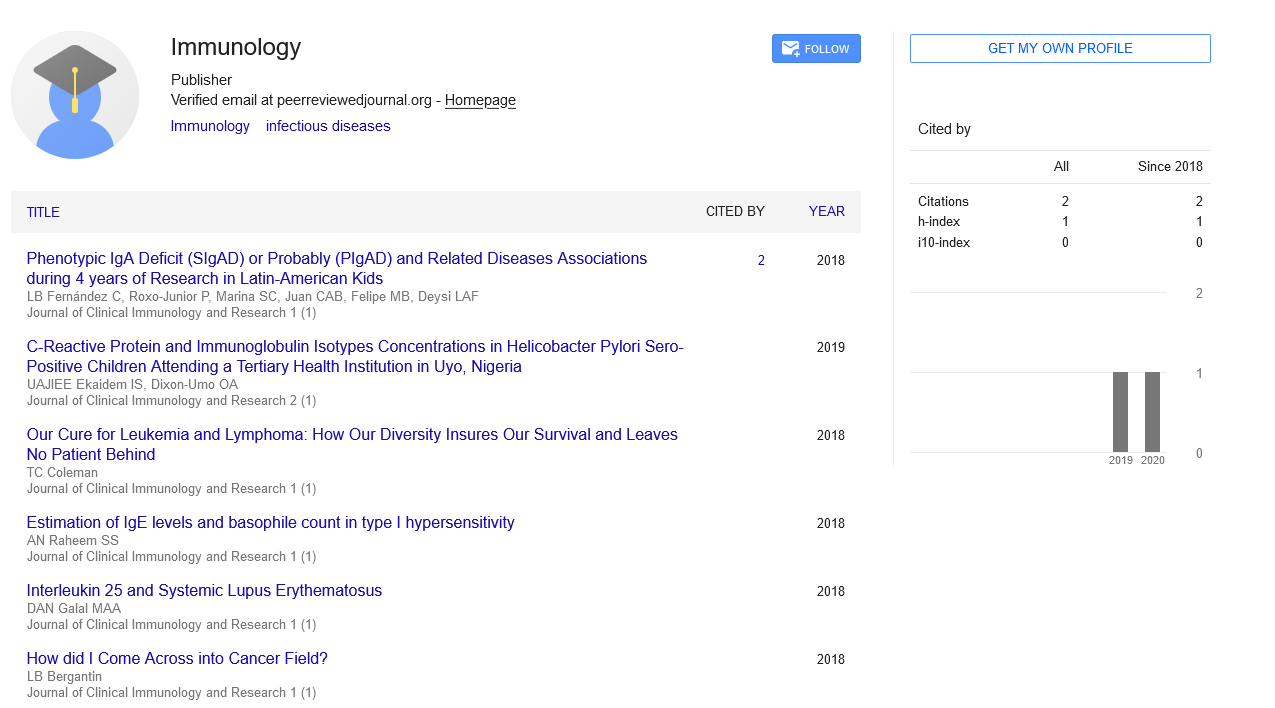Editorial, J Clin Immunol Res Vol: 4 Issue: 3
Inflammatory Responses and Phagocytosis
Arman Qureshi*
Department of Genetics, Pakistan Jordan Medical College, Pakistan
*Corresponding author: Arman Q, Department of Genetics, Pakistan Metropolitan Geriatric Medical College, Pakistan; E-mail: arman 676@gmail.com
Received date: June 05, 2021; Accepted date: June 20, 2021; Published date: June 29, 2021
Keywords: lymphatic cells
Introduction
The innate system relies on the popularity of certain foreign molecules to stimulate two sorts of innate immune responses: inflammatory responses and phagocytosis. The adaptive system, on the opposite hand, consists of more advanced lymphatic cells that are programmed to differentiate between specific "non-self" substances within the presence of "self". The reaction to foreign substances is etymologically described as inflammation, aiming to assail fire. The non-reaction to self-substances is described as immunity - aiming to exempt. These two components of the system create a dynamic biological environment where "health" are often seen as a physical state where the self is immunologically spared, and what's foreign is inflammatorily and immunologically eliminated. "Disease" can arise when what's foreign can't be eliminated or what's self isn't spared. The bioactive constituents of MO are identified in most parts of the plant the precise constituents isolated from MO mainly include flavonoids, glucosinolate and isothiocyanate phenolic acid, alkaloids and sterols and terpene. The constituents of the leaves and seeds were most often reported. supported the phytochemical analysis, phenols and alkaloids are more abundant within the leaves than within the seeds, while flavonoids, saponins , and anthocyanins are more abundant within the seeds. Besides, other forms of nutrients are present in high levels within the processed products of MO, including variety of fatty acids derived from the seed oil various sorts of minerals from the dried leaf powder and high-quality carbohydrates from refined gum exudates. B cells are essentially activated within the lymph nodes draining the injection site. Vaccine antigens reaching the subcapsular sinus by freefuid diffusion are haunted by specifc subcapsular sinus macrophages and translocated into the B-cell zone. The B cells equipped with surface B-cell receptors49 capable of binding to the vaccine antigens are activated and migrate to the interface between the B-cell (follicle) and therefore the T-cell zones. There, B cells engage T cells and initiate their proliferation. The cumulative amount of costimulation signals received by B cells determines their fate. 50 Protein antigens (which are haunted and displayed as small peptides on the surface of APCs) activate Tfh cells. This induces a highly effcient B-cell differentiation pathway, through specifc structures during which antigen-specifc B cells proliferate and differentiate into antibodysecreting plasma cells or memory B cells.51 Polysaccharide antigens that fail to recruit Tfh cells into the response don't trigger GCs, such they elicit only short-lived plasma cells leading to weaker and fewer durable antibody responses with no immune memory. Those critical of the pharmaceutical industry frequently begin from the position that folks got to be shielded from greedy and unscrupulous companies and scientists. they will point to the very unfortunate occurrences of graft, fraud, and misconduct by scientists and industry executives, and unethical behavior in university laboratories and community physicians’ offices. These problems notwithstanding, development of latest and better drugs is sweet for people and animals. within the absence of a government-controlled drug development enterprise, our current system relies predominantly on investor-owned pharmaceutical companies that, like other companies, have a profit motive and an obligation to shareholders. Product liability laws are intended to guard consumers from defective products. Pharmaceutical companies are often sued for faulty design or manufacturing, deceptive promotional practices, violation of regulatory requirements, or failure to warn consumers of known risks. Socalled “failure to warn” claims are often made against drug makers even when the merchandise is approved by the FDA. Although the normal defense offered by manufacturers in such cases is that a “learned intermediary” (the patient’s physician) wrote the prescription for the drug in question, the increase of direct-to-consumer advertising by drug companies has undermined this argument. With greater frequency, courts are finding companies that market prescribed drugs on to consumers responsible when these advertisements fail to supply an adequate warning of potential adverse effects. a world expert panel assessed the minimal clinically important difference in joint damage (from a clinician’s perspective). They used hand and foot radiographs to correlate their findings with the littlest detectable difference on the Sharp/van der Heijde and therefore the Larson/Scott methods.29 Results suggested that the littlest detectable difference on the Sharp/van der Heijde score reflected a minimal clinically important difference, while the Larson/Scott method was too insensitive to work out relevant changes. This study, however, didn't take minimal important differences from a patient perspective into consideration. Two people independently reviewed abstracts; if both reviewers agreed that the study didn't meet eligibility criteria, it had been excluded. We obtained the complete text of all remaining articles. Records were considered for exclusion if they didn't meet preestablished eligibility criteria with reference to study design or duration, patient population, interventions, outcomes, and comparisons to medications outside our scope of interest.
 Spanish
Spanish  Chinese
Chinese  Russian
Russian  German
German  French
French  Japanese
Japanese  Portuguese
Portuguese  Hindi
Hindi 